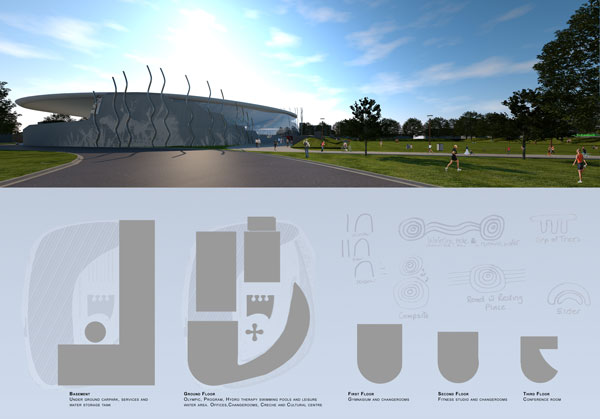Our design celebrates and acknowledges the traditional custodians of this land the Gadigal people of the Eora Nation and its Elders past and present to the benefit of the local community ensuring engagement and inclusion of all.
Through extensive research by Code Green many elements of the indigenous history would be incorporated into the design. Code Green ensures that heritage and local environments must be incorporated into everyone of their designs. On this particular site boomerangs were significant as well as oysters and wind.
Gunyama is an Aboriginal word meaning “wind from the southwest” which is reflective of the microclimate of the area. This environmental aerodynamic is another key influence on the projects goal to ensuring that the elements of earth, air and water are all integrated seamlessly into the artistry and sustainability of the design.
The building design is inspired by the shape of two linked boomerangs. The first, with a solar panel lined roof that will shimmer like the scales of a fish, under which the aquatic centre is housed. The ceiling will have a pearl like finish, mirroring the Sydney rock oyster.
The second, which houses the Arts Hub, has a green roof incorporating and reintroducing local indigenous plant species to the area to attract native birds and insects. The ceiling is constructed with local timber, reinforcing the element of the boomerang in the interior.
Storm water from both boomerangs will be captured and harvested for landscape irrigation and sewage systems.
Both boomerangs will appear suspended, as the angled external walls are predominantly glass. A sculptural metal façade on the southern side of the aquatic centre represents a shield protecting the structure from the southerly winds. The artistic curved poles around the structure symbolise water pathways. The three transparent curved feature poles adjacent to the entrance will be used as visual water storage tanks.
The external swimming pools nestle between the two boomerangs like waterholes protected from the elements. The landscaping throughout the site incorporates the Aboriginal iconography in its design, in particular the symbols for meeting places in the outdoor spaces. Indigenous artist BiBi Barba was invited as the cultural consultant by Chris to review the design elements that Chris incorporated into the design.
Gunyama Park incorporates a full-size synthetic sports field and recreation park.
Underneath the raised grass spectator area of the sports field are amenities including café, change rooms, public toilets, and storage areas, all of which are incorporated within converted recycled shipping containers.
The recreation park will feature BBQ/picnic areas, Fitness Park and a dedicated skate park, all which are linked by a series of joint cycle and pedestrian pathways. Dotted with rest stations and bubblers, these pathways lead to the entrance of the aquatic centre and a proposed pedestrian/cycle bridge over Joynton Avenue to the new Library precinct.
An inclusive approach to accessibility across the diversity of requirements of people with disabilities is incorporated in every aspect of the design.
Environmental sustainability is intrinsic in many of the physical features of the design, but equally important is social sustainability and accountability. What will truly give life to the structure is a design that will encourage and support a sense of community is itself. We feel that this is what is at the very heart of our design.
Code Green collaborated with “Impact Multi Media” director Shane Gates on this project with his extensive 3D design knowledge.
Awards:
Finalist – City Of Sydney, International Design Competition





